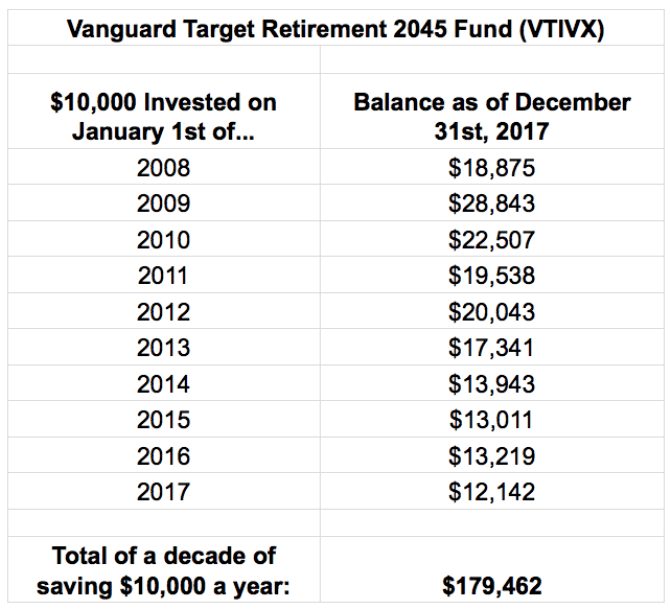 Instead of just looking at one year of returns, here’s an annual exercise that helps you look at the bigger picture. You may know the 10-year historical return of the S&P 500, but most of us didn’t just invest a big lump sum of money a decade ago, and most of us don’t just invest in the S&P 500.
Instead of just looking at one year of returns, here’s an annual exercise that helps you look at the bigger picture. You may know the 10-year historical return of the S&P 500, but most of us didn’t just invest a big lump sum of money a decade ago, and most of us don’t just invest in the S&P 500.
Investment benchmark. There are many possible choices for an investment benchmark, but I chose the Vanguard Target Retirement 2045 Fund. This all-in-one fund is low-cost, highly-diversified, and available in many employer retirement plans as well open to anyone with an IRA. In the early accumulation phase, this fund is 90% stocks (both US and international) and 10% bonds (investment-grade domestic and international). I think it’s a solid default choice where you could easily do worse over the long run.
Investment amount. For the last decade, the maximum allowable contribution to a Traditional or Roth IRA has been roughly $5,000 per person. That means a couple could put away at least $10,000 a year in tax-advantaged accounts. If you have a household income of $67,000, then $10,000 is right at the 15% savings rate mark.
A decade of real-world savings. To create a simple-yet-realistic scenario, what would have happened if you put $10,000 a year into the Vanguard Target Retirement 2045 Fund, every year, for the past 10 years. You’d have put in $100,000 over time, but in more manageable increments. With the handy tools at Morningstar and a quick Google spreadsheet, we get this:

For every $10,000 you put in annually over the last 10 years, you would have a ~$80,000 investment gain on top of the $100,000 in contributions. For example, if you were a couple that both maxed out their 401k and IRAs at roughly $20k each or $40k total per year, that would leave you with a gain of roughly $360,000 over the last decade (and a total balance of $760,000).
Some of that money was invested right before the crash in 2008/2009, and some has only been in the market for a few years. $10,000 invested in the beginning of 2008 would have dropped down to $5,500 in value before the rebounding. Not every year will turn out to be as good as this year, but taking it all together provides a more balanced picture.
Earn money, save a big chunk of it, and then invest it in your choice of productive assets. Keep calm and repeat. The investment side of our path to financial freedom can be mostly explained by such behavior. (Add in maxing out a 401(k) each year as well if you can.) Something as accessible and boring as the Vanguard Target Retirement Fund can make you rich. You don’t need a secret trading strategy or exclusive hedge fund manager.
 The Best Credit Card Bonus Offers – 2025
The Best Credit Card Bonus Offers – 2025 Big List of Free Stocks from Brokerage Apps
Big List of Free Stocks from Brokerage Apps Best Interest Rates on Cash - 2025
Best Interest Rates on Cash - 2025 Free Credit Scores x 3 + Free Credit Monitoring
Free Credit Scores x 3 + Free Credit Monitoring Best No Fee 0% APR Balance Transfer Offers
Best No Fee 0% APR Balance Transfer Offers Little-Known Cellular Data Plans That Can Save Big Money
Little-Known Cellular Data Plans That Can Save Big Money How To Haggle Your Cable or Direct TV Bill
How To Haggle Your Cable or Direct TV Bill Big List of Free Consumer Data Reports (Credit, Rent, Work)
Big List of Free Consumer Data Reports (Credit, Rent, Work)
Jonathn,
Do you find this article to be true?
Why I Am Selling My Favorite ETF
A combination of VTI and VXUS appears to be superior to VT.
It turns out that the combination of VTI and VXUS covers more stocks at a lower expense ratio than VT, while maintaining almost identical country exposures.
https://seekingalpha.com/article/4135119-selling-favorite-etf?page=2
I would agree that I would rather own a combination of VTI and VXUS instead of just owning VT for those reasons you listed.
Now do a version of it for the Japanese Stock Market. Given the current anti-immigration sentiment and aging workforce ( sans immigrants), we may look like Japan in not too distant futures ( too many retirees and not enough youngsters).
The Vanguard Target Retirement does include the Japanese stock market, nearly (but not quite) in proportion to its world market capitalization. It is 60% US/40% World ex-US while right now the cap-weighted breakdown is roughly 53% US/47% World ex-US. This diversification can help as if you are holding the world in market-cap weight, you are less exposed to any single country’s demographics.
Jonathan,
Thanks for charting it out. It really is impressive to see how simply investing in high quality, diversified index funds can provide similar (if not better) growth than picking out individual stocks.
In addition to the total value in your above example, you would also be looking at about $3,600 in forward annual dividends from that fund. Not bad at all.
– Desi Guy.
Man I struggle with this concept so much… We see so many people talking about savings and retirement investing for early FIRE, but your chart just puts it all into perspective for me: $179,000 is not going to change my life.
Unless I can follow the same strategy and deposit $100k/yr, it’s not going to create a meaningful enough impact to really change my life early. So the actual problem becomes, how I generate more income faster.
Thanks so much for writing this post… I have no idea why all these frugality blogs are touting save half your income, when in reality that is like $15k post tax.
It can be discouraging how slow the compound returns train is to get started, and as you note ten years worth of $10k investments is unlikely to turn into anything particularly revolutionary for most Americans. In fact, if you do the above experiment modeling a straight 7% annual real return, then you’d get only $138k, which might be more accurately reflective of purchasing power accumulated in today’s dollars going forward.
The problem is that you didn’t have much money earning more money for you yet, for most of that period. But if you save $10k/yr for twenty years, by the same calculation you suddenly end up with $410k in today’s dollars — nearly four times as much for only twice the investment!
And then if you keep it up for 30 years, guess what: $945k!
Just about a million dollars, by consistently saving and investing that relatively small amount.
If $15k is half someone’s post tax income, an annual investment of that much is projected (@ 7% real return) to become $615k in twenty years or $1.4 million in thirty! Thirty years may not seem like anything to get excited about, but careers typically last 40-50 years. Even chopping ten years of full time undesirable work out of someone’s life is extremely significant. Especially compared to reaching normal retirement age 10-20 years later with few assets to speak of, as so many do.
And there’s no reason for a healthy chunk not to be invested pre-tax, which lets you get more bang for your investment buck (ie more money to spend for the same investment, or more investment for the same income, or some combination).
It’s after 20 years that the life changing really starts, that $180k becomes 4 or 500,000, another 10 years and you may have your million. If you never start, then in 10 years, you may have nothing. Same for 20 and 30. Course enjoy your life too. Find a middle road, where you can save some, spend some and still enjoy life.
If you only have fidelity, check out FFNOX, very similar. VTIVX is a 90/10 while FFNOX is 85/15
If you did save more like $15k per year, after 10 years you would have something closer to $270k. If you are currently living on $15k per year after taxes and savings, you would need $375k at a 4% withdrawal rate to replace the income you currently live on. So, you couldn’t reasonably retire after 10 years of saving, but you could after around 15-17 years, which means you could check out of the workforce around 40, which is still pretty early to retire in my book.